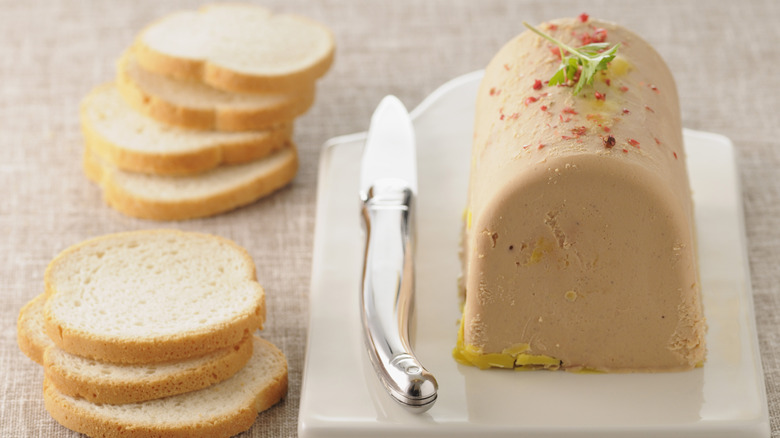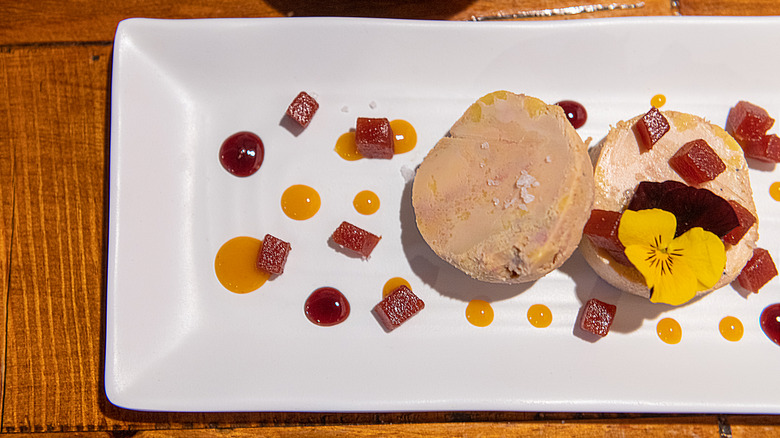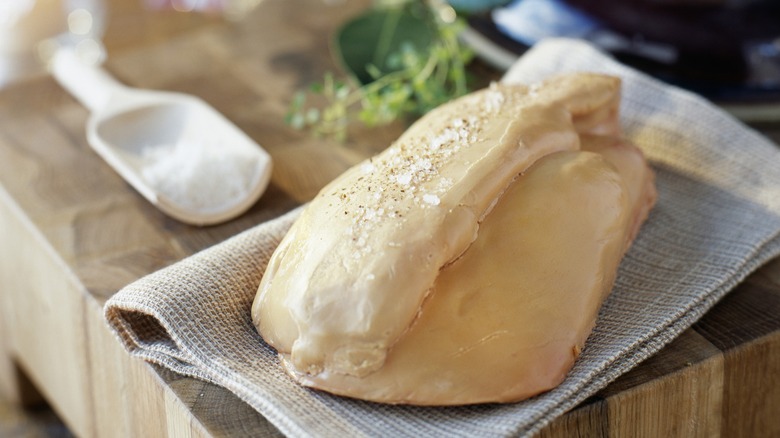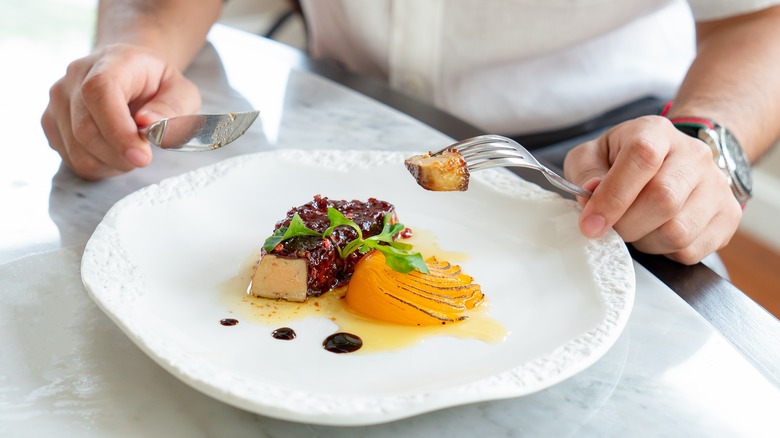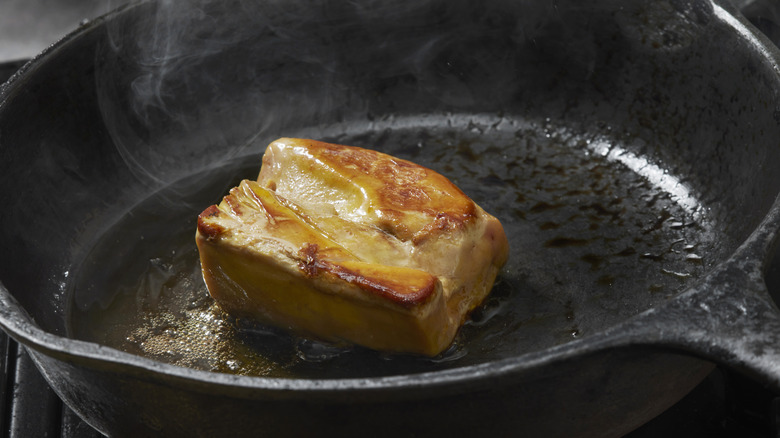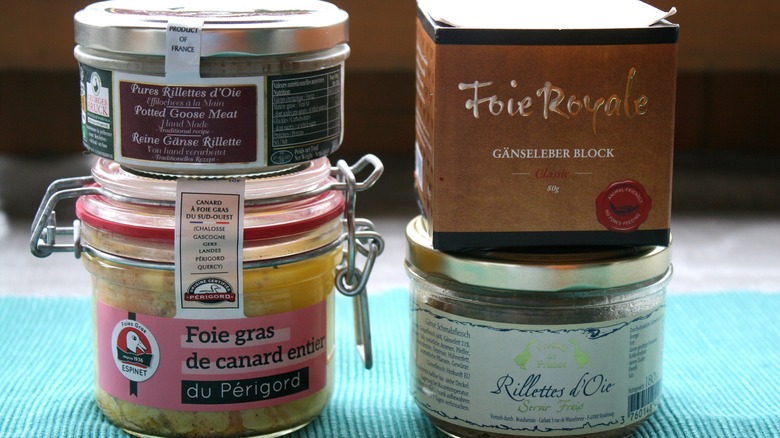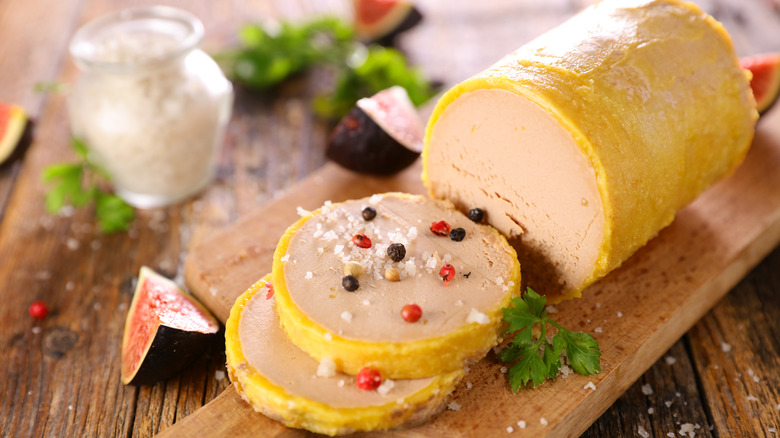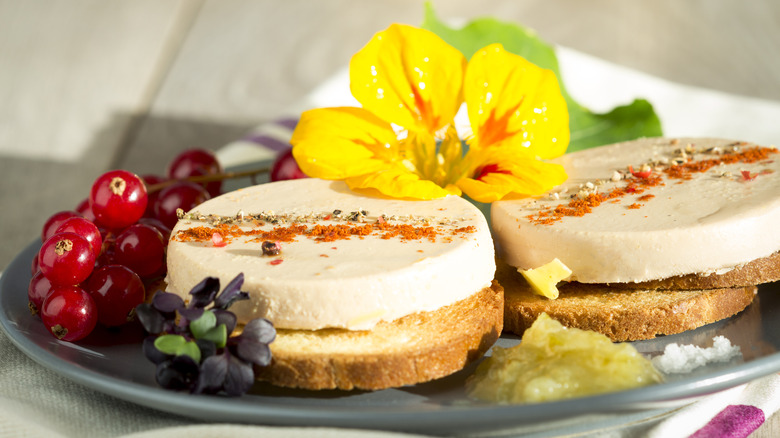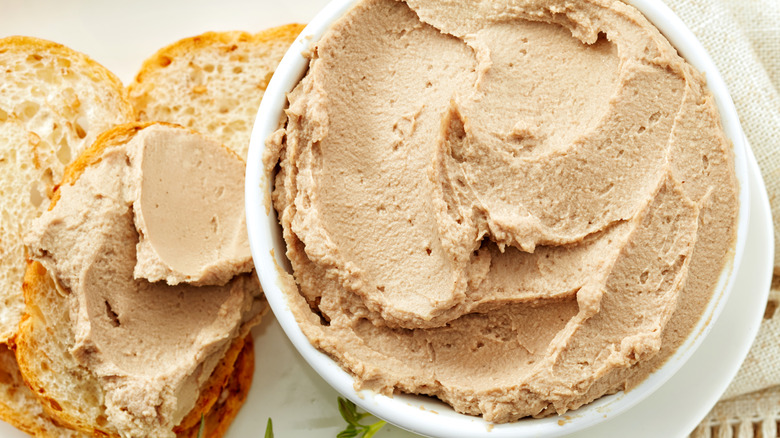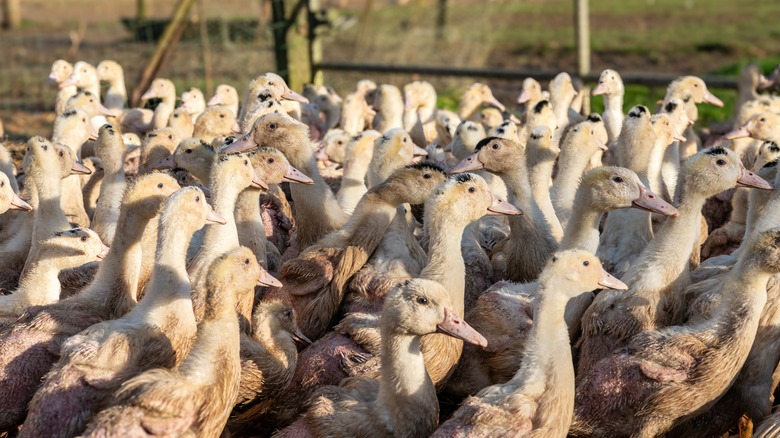What Is Foie Gras And Why Is It Banned In So Many Countries?
We may receive a commission on purchases made from links.
Do you know what foie gras is? If your answer is no, then you're not alone. While many have heard the term, not everyone knows what it means. Whether you came across the name on a menu at a fancy restaurant, heard a few friends talking about it, or even had a chance to taste it before, you may be wondering what foie gras is. You might be even more intrigued to learn why this food item has been banned in several countries.
Foie gras is an interesting dish — with roots that trace all the way back to ancient Egypt and the Roman Empire. In the next few slides, we'll share more information about what exactly foie gras is, what it tastes like, and how it has evolved since the time of the pyramids and pharaohs. And, yes, we'll also share some information about why this controversial food has been banned in several countries.
What is foie gras?
Foie gras is a French word that translates to fatty liver. Seen as a delicacy in France, along with many other regions of the world, it refers to a fattened duck (or sometimes goose) liver. While foie gras may be a French word, the history of this delicacy traces all the way back to ancient Egypt.
Ancient Egyptians discovered that migratory ducks and geese ate much more than normal when preparing to migrate, storing these additional calories in their livers as fat. Foie gras remained popular in ancient Egypt, while the process of making it was shared with other regions. Ancient Romans are credited with stepping their production of foie gras up a notch by experimenting with how different types of feed, specifically fruits, for the ducks or geese could enhance the flavor of the fatty liver. At that time, the Romans referred to the dish as iecur ficatum, which translates to fig-stuffed liver.
How is foie gras made?
Foie gras is the fatty liver of a duck or goose. Because the liver of a duck or goose doesn't naturally become fattened, aside from specific times of the year, to make the delicacy, the liver of the animals must be force-fattened. To accomplish this goal, a process called gavage is used. This refers to force-feeding the ducks and preventing them from exercising to work off any additional calories they are forced to consume.
The liver of the ducks and geese is targeted through gavage during the final weeks before the birds are slaughtered to make the foie gras. Because the ducks do not naturally want to eat as much as they are forced to during gavage, to fatten their livers sufficiently for foie gras, plastic or metal feeding tubes are used to force them to eat. These feeds are typically high in corn, which will fatten the liver the most. The specific amount the birds are fed varies between feeds. The birds are fed less than half a pound at a time earlier in the process, while the final feeding consists of about 1 pound of food.
Through the excessive feeding, the liver of the birds may be enlarged to up to 10 times the size of a normal liver. Foie gras can contain up to 65% fat by weight, compared to the up to 31% fat by weight content of other liver types or even up to 36% fat by weight content of some meat cuts.
What does foie gras taste like?
If you've never tried foie gras, you may be curious to learn what it tastes like. While the taste can vary depending on the type or grade of the foie gras, there is one common denominator: It has a very rich flavor. Remember, to make foie gras, the liver of the duck or goose is fattened. With that high fat content — up to 65% — it is no wonder foie gras is very buttery and rich.
Foie gras may be made from either duck or goose liver. As you might expect, the taste will vary depending on which bird the fattened liver comes from. While goose foie gras has a milder flavor and a smoother texture, foie gras made from duck has a stronger flavor. Some note that the flavor is mildly gamy or describe the taste as similar to wine. If you don't consider yourself a foie gras connoisseur, you may have trouble distinguishing the taste of the two varieties, particularly in canned or preserved products.
How do you cook with foie gras?
There are a few different ways to cook and serve foie gras. If you purchase a whole foie gras, the first thing you must do before cooking it — regardless of how you plan to cook it — is prepare it. This involves cutting off any small pieces of the gallbladder that may still be attached to the liver (they should be green and relatively easy to spot) and then using your hands to divide the lobes of the liver so you can remove the veins.
Once you've prepped the foie gras, one popular way to cook it is by searing slices in butter. Another option is to purée the foie gras (after cooking it) to create a mousse. Foie gras can also be poached (called foie gras torchon) before slicing into smaller pieces to serve as an appetizer. Another choice is to make a pâté (also called terrine of foie gras) by pressing the raw foie gras into a mold and cooking it in a hot water bath.
Just as you want to pair oysters with the right wines, the right pairings are also essential when serving foie gras. A popular option is to serve the fatty liver with brioche or other breads. Others enjoy it with fruit, marmalade, fig confit, other spreads, or even nuts.
Where can you buy foie gras?
If you want to buy foie gras, there are a few different ways you can do so. First, depending on where you live, you might be able to find the fatty liver meat at your local grocery store. Some stores, such as Wegmans, Whole Foods, and Safeway, display foie gras availability in select locations. Check with your local grocery store to see whether foie gras is available or if they'd be able to place a special order for you.
You can order foie gras online if you can't find foie gras locally. Various sellers on Amazon offer different varieties of fresh or canned foie gras. Alternatively, you can order foie gras directly through a business that produces the delicacy or procures it from manufacturers. A few of these businesses that offer online ordering include Hudson Valley Foie Gras, D'Artagnan, Petrossian, Fossil Farms, and Caviar Russe.
Of course, you can also find foie gras on the menu of select restaurants. You're most likely to be able to order it at a fine dining restaurant. If you ever get the opportunity to travel to France, you may even be able to find it at one of Ina Garten's favorite food destinations.
How do you store foie gras?
If you purchase foie gras to try at home, it is essential to know the best way to store it. Proper storage will not only ensure the foie gras tastes good but also help ensure you don't threaten your health or that of anyone else with food poisoning. The best way to store this delicacy will vary depending on whether you have raw, semi-cooked, or canned foie gras.
Raw and semi-cooked foie gras are not shelf stable — they must be refrigerated. Wrap whole, raw foie gras with plastic wrap before storing it in the refrigerator to keep it fresher for longer. Raw duck foie gras can last for up to 10 days, and raw goose foie gras can last for up to 15 days when refrigerated. If you have semi-cooked foie gras, it must also remain refrigerated. Once opened, it is best to eat within one day. If unopened, the package can last for up to three weeks
Canned foie gras is one of those unexpected foods that does not need to be refrigerated. It also lasts much longer than raw or semi-cooked foie gras. This is because the canned version of the delicacy is sterilized and properly preserved, allowing it to last for up to four years. For the best taste and freshness, store the canned foie gras in a cool and dark location, such as a cooler basement (under 60 degrees Fahrenheit).
Foie gras nutritional information
Nutrition information for foie gras is a bit mixed. Generally speaking, it will be best to eat it in moderation as part of a balanced diet. While it is rather high in fat and calories (as you'd probably expect, given that it is literally a fatty liver), there are also some beneficial vitamins and minerals in each serving.
Let's start with the "bad." Just 2 ounces of foie gras has around 250 calories and 24 grams of fat. Those 24 grams of fat represent 37% of your daily value — all from something that weighs about the same as a single large egg. On the plus side, each 2-ounce serving of foie gras also provides 6 grams of protein, more than 200% of the recommended daily value of vitamin B12, more than 60% of the recommended daily value of vitamin A, and more than 25% of the recommended daily value of copper.
Foie gras vs. pâté
While some may use the terms foie gras and pâté interchangeably, they are different. While both foie gras and pâté are seen as delicacies, there are key differences between the two. Foie gras is the fattened liver of a duck or goose. Pâté is a spreadable dish combining ground meat, seasonings, and other ingredients. There are different ways of preparing pâté; it may have a coarse texture or a silky smooth consistency, resembling a mousse. You can technically make pâté from any meat, though it is most commonly associated with more expensive varieties. Liver, pork, chicken, lobster, and even mushroom are common proteins used to make pâté.
Here is where it gets a bit confusing — and why some people confuse foie gras and pâté. You can make pâté from foie gras. Pâté de foie gras is one of the most expensive forms of pâté. According to French law, true pâté de foie gras must have no less than 80% foie gras (so only 20% of the mixture can consist of herbs, alcohol, or other ingredients). But, again, remember, while foie gras can be made into pâté, all pâté is not foie gras.
Why is foie gras banned in some countries?
Foie gras is banned in some countries because many feel that the way it is made is cruel. As we shared earlier, for the ducks and geese livers to become fatty enough to make foie gras, the animals must be force-fed. Long tubes are placed down the birds' throats, and much more food than they would naturally consume is shoved down these tubes into their stomachs. The process can result in death or injuries to the ducks or geese; some suffer from broken beaks, trauma, internal injuries, and more.
Currently, foie gras is not banned in the United States. Chicago and California tried to outlaw the delicacy, but court rulings overturned the policies. As of this writing, India is the only country that has placed a total ban on producing and selling foie gras. Other countries have production bans, which means they allow foie gras to be sold but have outlawed it from being made in the country. The countries that currently have a production ban on foie gras include Argentina, Czech Republic, Denmark, Finland, Germany, Ireland, Israel, Italy, Luxembourg, Netherlands, Norway, Poland, Sweden, Switzerland, and the U.K.
